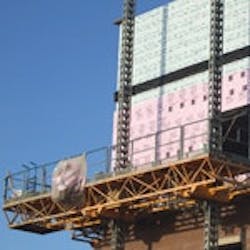Wet insulation can cause myriad building problems – from troubles with structural integrity to issues of energy efficiency and occupant health. Read here about the problems caused by wet insulation … and what you can do about them.
The Problems
Structural integrity. Wet insulation is often in contact with steel structural members in commercial buildings. Structural damage occurs from rusted steel studs, corroded wall ties, and screws that hold the ties being continually wetted due to wet insulation. As deterioration advances, ties and braces loosen.
"Over time, loosened ties result in excess movement, which leads to cracked and discolored wall surfaces; in the worst cases, it even leads to partial collapse of veneer wall systems," says Ried Artis, public relations leader for Owens Corning’s building materials group.
Energy efficiency. Loss of thermal insulation value is a consequence of wet insulation – water conducts energy. "If insulation is wetted, it becomes a conductor of energy rather than a resister," Artis explains.
When insulation conducts energy rather than reflects it, it results in higher heating or cooling bills. "In the wintertime, for example, heat rises from the heaters; that heat goes through the ceiling of the roof and you lose that energy," says Fred Garcia, owner of Therma-Comfort. "If you have insulation on the top, the heat reflects back down so you’re conserving energy."
Health. Moisture caused by wet insulation contributes to mold and IAQ degradation. Mold needs mold spores, a food source, adequate temperature, and moisture to thrive; water is often the only element that can be controlled. "If we control and limit water in the wall by using good design, good construction, and good maintenance, there’s a good chance of controlling mold growth," says Artis.
The Sources
There are several sources of wet insulation due to construction and/or design flaws that contribute to insulation wetness.
Artis cites the following examples:
• Wetting of unprotected insulation from water during construction.
• Improper construction (poorly installed flashing or coping details, and poor seals around openings in the walls).
• Clogging air spaces in the wall and weep holes, which are intended to help with drainage.
• Failure to install water-resistant, continuous insulation, resulting in thermal bridging through steel stud framing, which leads to cold spots and condensation in the walls.
• Latent moisture generated inside during construction from curing concrete or drying spackling plaster.
• Infiltration of warm, moisture-laden air that mingles with cooler air, creating condensation and wetting.
• Absence of properly designed and installed air barriers.
The Solutions
Artis recommends using a three-stage approach to prevent wet insulation.
Stage No. 1: Design. When building a new building or remodeling an existing building, make sure it’s designed with sensitivity to potential design flaws and moisture sources. "Specify insulation materials, such as extruded polystyrene, that are moisture resistant and control thermal bridging and condensation locations," says Artis.
Stage No. 2: Construction. Pay attention to details. "Proper design and drawings are one thing," Artis says. "Proper installation is another." Inspect, verify, and manage latent moisture throughout construction. If necessary, use temporary dehumidification equipment.
Stage No. 3: Maintenance. Use qualified professionals and establish an annual routine inspection for copings at the top of parapet walls, visible flashings, lintels over windows, and control joint seals in masonry walls. Inspect for internal clues of moisture (peeling finishes or discoloration in walls or floors).
Unfortunately, water in insulation or wall systems is often not visible until it has already done damage. "Wet drywall may not be noticed until discoloration and mold set in," says Artis. Once those things appear, he says that repair work may be very extensive.
"Time and money spent on repairs and downtime can be minimized through vigilant maintenance, early identification of problems, and rapid remediation with drying machinery and dehumidifiers accurately positioned for maximum effect," explains Artis. "When water is detected, it’s important to identify the source so gutting and remediation can be performed with pinpoint accuracy."
Kylie Wroblaski ([email protected]) is associate editor for BUILDINGS.
